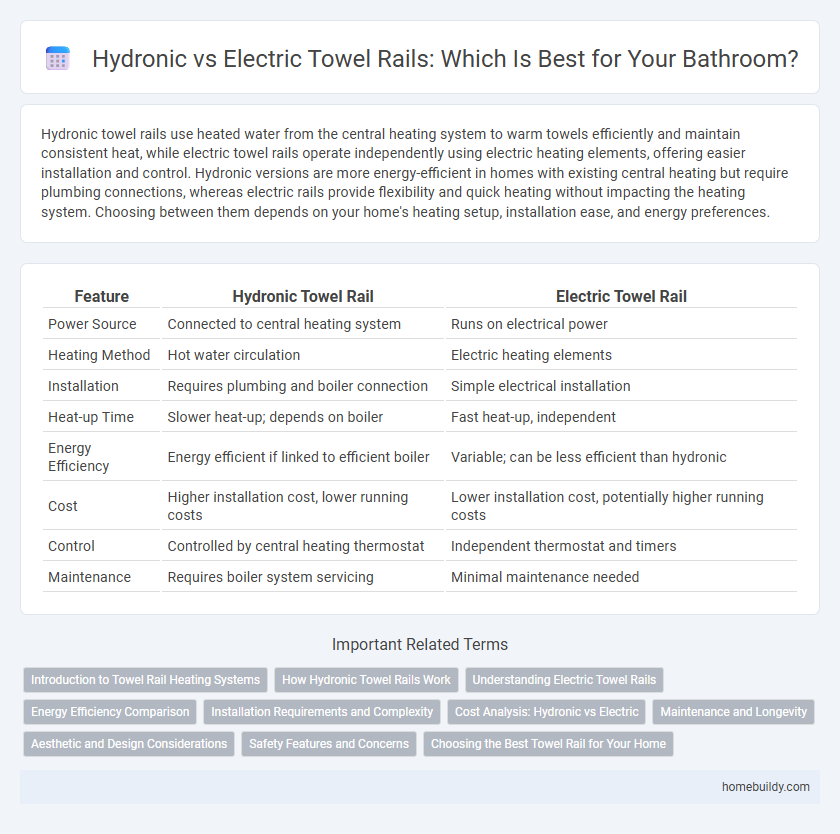Hydronic towel rails use heated water from the central heating system to warm towels efficiently and maintain consistent heat, while electric towel rails operate independently using electric heating elements, offering easier installation and control. Hydronic versions are more energy-efficient in homes with existing central heating but require plumbing connections, whereas electric rails provide flexibility and quick heating without impacting the heating system. Choosing between them depends on your home's heating setup, installation ease, and energy preferences.
Table of Comparison
| Feature | Hydronic Towel Rail | Electric Towel Rail |
|---|---|---|
| Power Source | Connected to central heating system | Runs on electrical power |
| Heating Method | Hot water circulation | Electric heating elements |
| Installation | Requires plumbing and boiler connection | Simple electrical installation |
| Heat-up Time | Slower heat-up; depends on boiler | Fast heat-up, independent |
| Energy Efficiency | Energy efficient if linked to efficient boiler | Variable; can be less efficient than hydronic |
| Cost | Higher installation cost, lower running costs | Lower installation cost, potentially higher running costs |
| Control | Controlled by central heating thermostat | Independent thermostat and timers |
| Maintenance | Requires boiler system servicing | Minimal maintenance needed |
Introduction to Towel Rail Heating Systems
Hydronic towel rails operate by circulating heated water through pipes connected to a boiler or central heating system, offering consistent and energy-efficient warmth. Electric towel rails use internal heating elements powered by electricity, providing quick heat and easy installation without the need for plumbing. Choosing between hydronic and electric towel rails depends on existing heating infrastructure, desired heating speed, and energy consumption preferences.
How Hydronic Towel Rails Work
Hydronic towel rails operate by circulating hot water from a central boiler system through pipes within the rail, heating the metal bars and drying towels efficiently. This method leverages existing home heating infrastructure, offering consistent warmth and energy efficiency during cold months. Unlike electric towel rails, hydronic models depend on the boiler's operation, making them ideal for integrated heating systems rather than standalone use.
Understanding Electric Towel Rails
Electric towel rails operate independently from a home's central heating system, using built-in heating elements to warm the rails quickly and efficiently. They provide consistent heat even when the central heating is off, making them ideal for year-round use and precise temperature control through thermostatic settings. Electric towel rails are energy-efficient options that enhance bathroom comfort by drying towels faster and reducing dampness.
Energy Efficiency Comparison
Hydronic towel rails use hot water from the central heating system, making them highly energy-efficient when connected to an efficient boiler or heat pump, as they utilize existing heat without additional electricity consumption. Electric towel rails, while easier to install and control with timers or thermostats, generally consume more electricity and can incur higher running costs, especially if used as the primary heat source. Choosing between hydronic and electric towel rails depends largely on the home's heating infrastructure and energy source efficiency, with hydronic systems favored for integrated, low-energy operation.
Installation Requirements and Complexity
Hydronic towel rails require connection to the central heating system, demanding professional plumbing expertise and integration with existing pipework, which can increase installation time and complexity. Electric towel rails offer straightforward installation with only an electrical connection needed, making them ideal for bathrooms without central heating or for simpler retrofit projects. The choice between hydronic and electric models hinges on existing infrastructure and the willingness to undertake more complex plumbing versus simpler electrical setup.
Cost Analysis: Hydronic vs Electric
Hydronic towel rails typically have higher upfront installation costs due to the need for integration with the existing central heating system, but they offer lower operating expenses as they utilize hot water from the boiler. Electric towel rails usually have lower initial costs and easier installation, ideal for retrofit applications, but incur higher electricity bills over time compared to hydronic models. Evaluating total cost of ownership, hydronic towel rails are more cost-efficient long-term in homes with central heating, whereas electric models provide flexibility and lower initial investment for properties without such systems.
Maintenance and Longevity
Hydronic towel rails require periodic system flushing and checking for leaks to maintain optimal function, while electric towel rails mainly need occasional dusting and electrical inspections to ensure safety. In terms of longevity, hydronic rails tend to have a longer lifespan due to their integration with central heating systems and durable materials. Electric towel rails, although easier to maintain, may experience shorter service life due to electrical component wear and potential overheating.
Aesthetic and Design Considerations
Hydronic towel rails often feature sleek, minimalist designs that integrate seamlessly with traditional and modern bathroom aesthetics, using metal finishes like chrome or stainless steel for a polished look. Electric towel rails offer versatile design options, including slimmer profiles and innovative shapes, since they don't require plumbing connections, enhancing flexibility in placement and style. Both types provide aesthetic benefits, but electric rails excel in customization, making them ideal for contemporary spaces prioritizing form and function.
Safety Features and Concerns
Hydronic towel rails operate using hot water from the central heating system, offering consistent warmth with low surface temperatures, minimizing burn risks and enhancing safety in homes with children or elderly residents. Electric towel rails feature built-in thermostats and overheat protection mechanisms, ensuring rapid heating while preventing electrical hazards and excessive heat exposure. Both systems require professional installation to comply with safety standards and avoid risks related to water leaks or electrical faults.
Choosing the Best Towel Rail for Your Home
Hydronic towel rails use heated water from your central heating system, offering energy efficiency and consistent warmth ideal for larger homes with existing boiler systems. Electric towel rails provide flexibility with independent control, making them suitable for bathrooms without central heating or for supplemental heating during colder months. Choosing the best towel rail depends on your home's heating infrastructure, energy preferences, and bathroom size.
Hydronic towel rail vs electric towel rail Infographic

 homebuildy.com
homebuildy.com